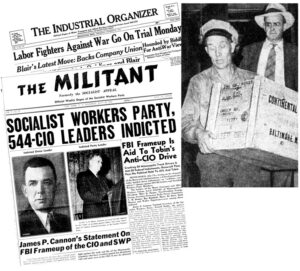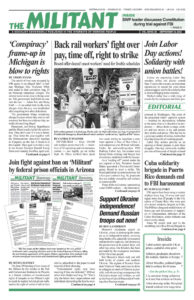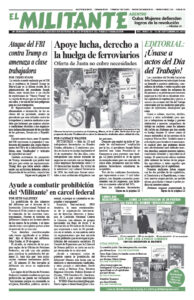
There are stepped-up attacks today by the capitalist rulers, their political parties — the Democrats and Republicans — and the FBI against constitutional rights, rights that are crucial for the struggles of working people. These attacks can be defeated, and these rights can be used, as we go into combat to advance our own class interests.
The origins and character of the rulers’ use of the FBI as their key political police force was most clearly revealed by the Socialist Workers Party’s historic 15-year political battle, combined with legal action, from 1973 to 1988. Federal Judge Thomas Griesa ruled in 1986 that decades of spying, harassment, frame-ups and disruption against the party by the FBI and other federal agencies violated the party’s fundamental right to carry out politics free from government interference.
The FBI violated the SWP’s rights under the First Amendment to the Constitution, which guarantees freedom of speech and association, and the Fourth Amendment, which protects the privacy of groups and individuals against arbitrary search and seizure by government agents. It was an unprecedented victory, one that can be used today.
Griesa, a Republican appointed to the bench by President Richard Nixon, ruled that the FBI’s use of informers against the SWP violated the rights of the party, and that covert wiretaps and break-ins of SWP offices and its Cointelpro disruption operation against the party were unconstitutional.
Government claims of legal authority — defended during the trial by top government officials — for their campaign of spying, disruption and provocation against the party were rejected by the court. This is a ruling that is of increasing importance today.
Shining a spotlight on this genuinely totalitarian expansion of executive power, and laying bare its deep roots, was one of the major accomplishments of the SWP’s case.
Gov’t fights for right to spy, disrupt
The government spared no effort in trying to win a different outcome. Robert Keuch, deputy assistant attorney general and the third-ranking official in the Justice Department at the time, took the stand and testified that FBI operations against the party were constitutional because the president authorized them.
In September 1939 World War II broke out in Europe. President Franklin Roosevelt authorized the FBI to go after the SWP and other “subversives,” Keuch testified, above all those “who were trying to influence public opinion to keep the United States out of war.”
Within weeks of Roosevelt’s decree, FBI agents simultaneously descended on the homes of Teamsters’ union leaders in Des Moines and Sioux City, Iowa, and in Omaha, Nebraska. Seven union leaders were framed on charges of burning a bakery truck and sentenced to prison for two years.
“The FBI is systematically persecuting the labor movement as part of the Roosevelt government’s preparations for dragging America into war,” Thomas Smith, secretary-treasurer of Teamsters Local 554 in Omaha, said in the union’s newspaper, the Northwest Organizer. “Roosevelt wants first to crush the labor movement, especially its most successful and progressive sections.”
In June 1941, FBI agents and U.S. marshals raided the branch offices of the Socialist Workers Party in Minneapolis and St. Paul, Minnesota, and arrested leaders of the party, many of them members of Local 544, under the newly adopted Smith Act, a gag law making the expression of ideas a crime. The government’s goals were to purge the labor movement of those who would not go along with imperialist war goals, erase the stronghold of union power and democracy represented by the Minneapolis Teamsters and try to drive the SWP into functioning underground.
They completely failed on this last goal. One of the party’s first responses was to nominate James P. Cannon, its national secretary and one of those facing trial, for mayor of New York City. The SWP used that campaign to publicize its revolutionary working-class program and, when the frame-up case went to trial, turned the Minneapolis courtroom into a platform from which to explain the party’s views on the war and initiate a nationwide defense effort that continued until the last of the 18 defendants was released from prison.
The SWP was not the only target of these government attacks, then or today. When Black newspapers, including the Pittsburgh Courier, launched the “Double V” campaign — calling for a fight for Black rights here at home at the same time as the war abroad — Attorney General Francis Biddle summoned several editors of Black weeklies to Washington, D.C., threatening “to shut them all up” on charges of sedition.
As the war continued, the FBI expanded its army of informers and provocateurs in the labor and Black movements. By the end of 1942, there were nearly 24,000 stool pigeons reporting on union and political activities in almost 4,000 factories, mines, and mills.
The government’s use of the FBI to go after workers and others continued after World War II. In 1956, as the Montgomery Bus Boycott caught the nation’s attention, the White House and FBI Director J. Edgar Hoover launched its Cointelpro operations, first against the Communist Party, then against the SWP, Black organizations fighting Jim Crow segregation, and others.
FBI forced to admit spying on SWP
During the trial, the FBI admitted to maintaining 10 million pages on the SWP and YSA, files that contained evidence of thousands of unlawful acts committed by the FBI and its informers, including at least 208 burglaries of offices and homes of the SWP and its members, 12,000 days of listening “bugs” and 20,000 days of wiretaps — but didn’t reveal a single instance of lawbreaking by the party.
Why was it the Socialist Workers Party that took the lead in this initiative, with no fear of what would be uncovered? Why not the Communist Party, which had suffered more than the SWP from the FBI’s illegal campaigns of spying, harassment and disruption?
The SWP could take this step because, like any genuine communist organization, it has no program or policies kept secret from the working class. The party doesn’t say one thing in public and something different in its closed meetings. The SWP’s fight was widely covered in the press and won wide-ranging support from those of all stripes who supported constitutional rights. It inspired others — from Black Panthers to anti-Vietnam War fighters — to file suits of their own aimed at forcing out evidence of FBI spying and disruption against them and barring such actions.
From the onset, one of the most important issues in the SWP’s case was whether or not the FBI had the right to use covert informers to spy on and disrupt the party. To prove its case the party asked Judge Griesa to order the FBI to turn over files on government informers in the SWP. When the judge ordered a sample of 18 informers be produced, Attorney General Griffin Bell told the judge he was refusing to obey. The judge responded by finding him in contempt of court, the first such ruling in U.S. history.
Herbert Brownell, who had served as attorney general in President Dwight Eisenhower’s cabinet, also took the stand. He argued that when “intelligence” is involved, the government had the authority to ignore the Bill of Rights. Glaring at Judge Griesa, he said pointedly, “So far there has been no court decision which prohibited such activities in the field of intelligence.”
That ended with the ruling in the SWP’s case finding the FBI’s conduct illegal and codifying in court for the first time constitutional rights and liberties fought for over many years.
After Griesa’s ruling, which included damages to the party of $264,000, there was one more chapter in the fight. The FBI and other government cop agencies claimed they had a need to be able to rifle through the files they had assembled illegally if they suspected they would shed light on a crime in the future. The judge issued an injunction barring them from ever doing so.
“Lawyers are accustomed to describing cases in which they have been successful as ‘historic,’” Leonard Boudin, the SWP’s lead attorney, said of the fight. “But no one could challenge that description of Socialist Workers Party vs. Attorney General.”

